READ
MORE

American Art Advisor
A New Way To Sell Art At Auction
The Art Auction Partnership Program – 19th & 20th Century Paintings
FERN COPPEDGE
(1883-1951)
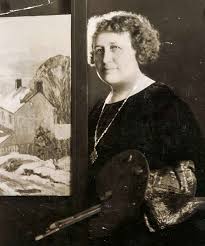

Fern (Kuns) Coppedge, Dessie (Kuns) Garst, George Dilling Kuns, Margaret Effa Kuns
Vada Dilling Kuns, Maria (Dilling) Kuns, John L. Kuns, Mary (Kuns) Klepinger
“People used to think me queer when I was a little girl because I saw deep purples and reds and violets in a field of snow. I used to be hurt over it until I gave up trying to understand people and concentrated on my love and understanding of landscapes.
Then it didn’t make any difference.”
— Fern Coppedge
Fern Isabel Kuns was born in the tiny town of Cerro Gordo, nestled in the heart of central Illinois farm country some 12 miles from Decatur. The daughter of farmer John Leslie Kuns and Maria Dilling Kuns, Fern was born on July 28, 1883 and died in New Hope, Pennsylvania on April 21, 1951 at the relatively young age of 67. Raised with four sisters and a brother (photo above) Fern Kuns was a precocious child with bright blue eyes and an early appreciation of the art and beauty of her surroundings. Sadly, Fern's second brother, the Kuns’ firstborn child, Joseph, died at age 10 three years before Fern was born.
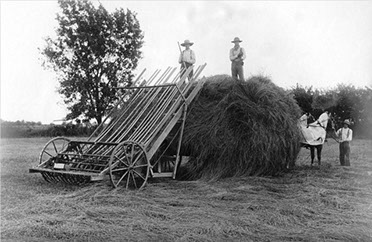
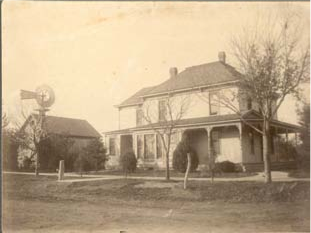
Decatur, Illinois 1889
Home of Fern Kuns and Family
McPherson, Kansas (circa 1900)
In 1886, the Kuns family moved to California for a year, which Fern’s oldest sister Mary recalled as the best year of her childhood. When potential opportunities didn’t work out they headed east for Kansas. Following several years of poor farm revenue, John Kuns had sold the land in Illinois he inherited from his father for a very low price to enable his children to get a good liberal education. In 1889, the Kuns' settled in McPherson, Kansas and occupied a house on the campus of McPherson College.
In 1896, at age 13, Fern travelled to Palo Alto, Calfornia with her older sister, Margaret Effa. Margaret, age 22, known as “Effa” to the family, attended Leland Stanford University while Fern attended Pasadena High School some 350 miles away. In California, Fern observed Effa painting in a watercolor class and was hooked on art. She also visited museums with Effa, her favorite sister, never imagining that someday she would be one of the famous artists whose oil paintings hang in the hallowed halls of the Pennsylvania Academy of Fine Arts, the Philadelphia Museum and The Michener Museum. In 1900, Fern returned to Kansas where she met her future husband, Robert William Coppedge (born in 1878.) On the morning of Saturday, January 2, 1904 Fern Kuns and Robert Coppedge were married in her parents home in McPherson, and the ceremony was followed by a four-course wedding breakfast. Others have mistakenly reported their marriage as taking place in 1910. (Fern’s wedding announcement will be in our book.)
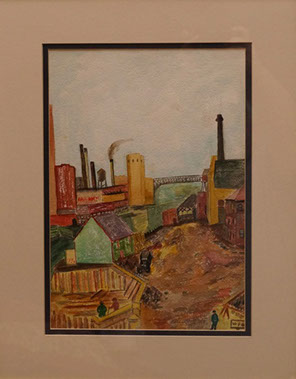
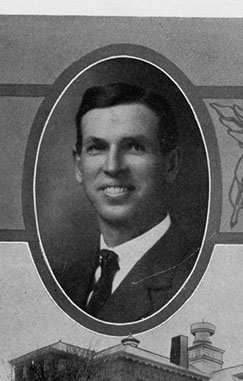
Watercolor by Margaret Effa Kuns
(probably Chicago circa 1935)
Photo courtesy of Kuns Family.
Robert W. Coppedge
Photo courtesy Topeka High School
Encouraged to pursue art by teachers, friends and family, including her husband Robert, an amateur artist, high school science teacher and principal, Fern completed her formal education in California and Kansas. She and Robert moved to Topeka in 1904 until they relocated to Pennsylvania in 1920 where they spent the rest of their lives. Robert continued to teach while Fern painted. In 1907, Fern enrolled at the Chicago Art Institute for a Summer Class in 1908. Fern was homesick for her husband and family but true to her passion for art she could not deny her calling. Although she loved children, for some reason Fern and Robert Coppedge never had any. Curiously, within the Philadelphia Ten women artists’ group, only 13 of the 30 members of married and only 4 had children.
After Chicago, she studied with American Impressionist superstar William Merritt Chase at the prestigious Art Students League in New York, and at the equally prestigious Pennsylvania Academy of Fine Arts (PAFA) in Philadelphia with Daniel Garber, the award winning Pennsylvania artist and art teacher. Beginning in 1917, Fern also studied with John Carlson at the Woodstock Art Colony. The year 1917 marks her first visit to Pennsylvania. She instantly fell in love with its quaint hills and towns which reminded her of Kansas. During her three decades in Pennsylvania, Fern Coppedge maintained homes and studios in Philadelphia, Lumberville and New Hope. These will be shown in our book, including Boxwood, the early American style stone house and studio Fern designed and built with architect Henry T. MacNeill in New Hope in 1929. Over the years Fern painted dozens of pictures of Boxwood (also known as “Boxwood Studio” where she held many exhibitions) but we have not yet found a photo of Boxwood from the 1930’s or 1940’s. In 1952, Boxwood was inherited by Fern’s nephew, John David Kuns. Recently, the greatly expanded waterfront residence on North Main Street was listed for sale at $4 million.
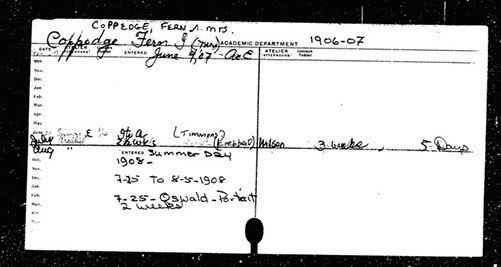
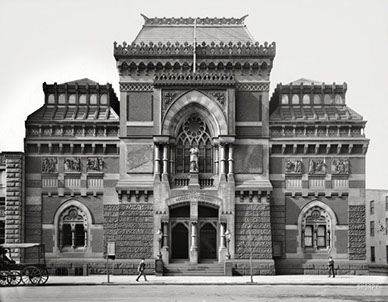
Fern’s 1907-1908 registration card at the Chicago Art Institute
The Pennsylvania Academy of Fine Arts (PAFA) circa 1900
In addition to the many museums which represent the work of Fern I. Coppedge (see museum page) Fern exhibited at numerous art clubs and organizations including The Plastic Club (winning a Gold Medal in 1924 and 1942), The National Association Of Women Artists (NAWA) and The Philadelphia Ten (1917-1945) where she participated in a women artists' resistance movement from 1922 to 1935. Not surprisingly, the art market of a century ago was controlled by men who often refused to accept certain women artists and paintings by women in their juried exhibitions. Hence, The Philadelphia Ten (which actually included 30 different women over the years) successfully created independent exhibitions, alliances and loyal patrons. Fern Coppedge won art contests and prizes every year from 1917 to 1947. While winter landscapes comprised most of her artwork, Fern also spent summers in Gloucester, Massachuetts starting in 1916 where she loved to paint brightly lit, colorful harbor scenes. Our book will feature a great story from 1916. Luckily for fans Fern created 1,000 to 1,200 paintings in her lifetime, many in Gloucester. More than 300 of her paintings have been sold at auction but most remain in public and private collections. Exciting new finds continue to turn up every year.
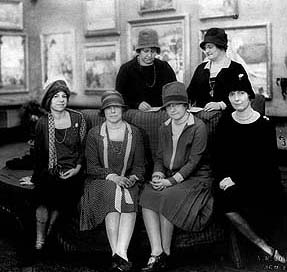
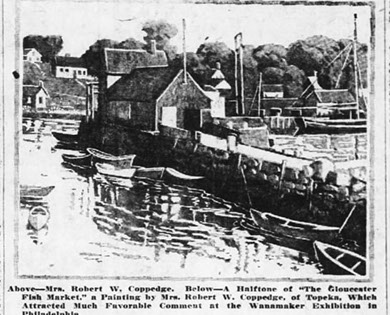
Fern Coppedge (top left) exhibiting with The Philadelphia Ten in 1928.
Fern Coppedge won art prizes every year for 30 years.
Credit: The Michener Museum, Fern Coppedge's Scrapbooks
SEEING PENNSYLVANIA THROUGH THE EYES OF FERN COPPEDGE
Unlike photographs and very realistic paintings, if you want to experience a unique and charming interpretation of what Bucks County, Pennsylvania looked like to America’s most creative snowy landscape artist, you’ve come to the right place. Fern Coppedge did not just paint snow scenes. She was obsessed with the beauty and aura of snow! “Pennsylvania Through The Eyes Of Fern Coppedge” is more than a clever phrase. In order to paint as long as possible during extremely cold weather, Fern removed the back seat of her car to paint from an enclosed warm area. She also tied her canvases to trees to fight off the wind, and she wore a bearskin coat (a family heirloom from Montana) and painted until her fingers literally froze! Unlike other New Hope Impressionists, Fern Coppedge did not “play by the rules.” When she looked at an outdoor scene, her eyes showed her two things. First, what a camera would capture. Second, what the scene looked and felt like to her and her imagination. Since childhood, Fern had been criticized for seeing colors that others couldn’t see in their surroundings. When she painted, these are the colors she used her brushes to apply to canvas in sparkling oil.
“In the waters shown in my paintings, there were a number of lobster traps. The fishermen were so much interested in the development of the picture of this familiar scene that in order to have an excuse to see it they would bring me a freshly boiled lobster, and the old sea captains would entertain me with thrilling stories of stormy nights spent in their little fishing schooners on the Newfoundland Banks and the Georges.”
— Fern Coppedge, Cape Ann, Massachusetts 1916
Fern Coppedge also did something that other Bucks County artists didn’t do. She re-arranged her compositions to reflect her view of reality: What is vs. What might have been. The Fern Coppedge version of photoshopping! Instead of dull brown residences, pink and turquoise houses magically appeared. Other buildings shifted locations or disappeared. Trees were personified. Almost devoid of people, Fern’s “view” of Pennsylvania was a wonderful transformation of what you and I would have seen. Which is not not to say it wasn’t really there. Like fiction writers who create characters we've come to know and love based on “a sense of reality” (like Harry Potter), so did Fern Coppedge leave behind a legacy of semi-fictional Pennsylvania that her fans, museums and art collectors, simply adore. That’s why she has become the most popular New Hope artist. She’s also our favorite artist.
Fern Coppedge was the only female member of The New Hope School. Although nationally recognized, she was not entirely accepted by “the Pennsylvania Boys”, a group of enormously talented artists whose greatness has only been fully recognized in the past 30 years. These artists will be praised in our book. (See also “The New Hope School” page.) This website is only a preview of our book, which will contain many more details, photos and stories of the fulfilling life of a little girl from Illinois and Kansas who yearned to create art. Like Dorothy in The Wizard Of Oz, Fern Coppedge may have started out in Kansas. But when she arrived in Pennsylvania, things changed!
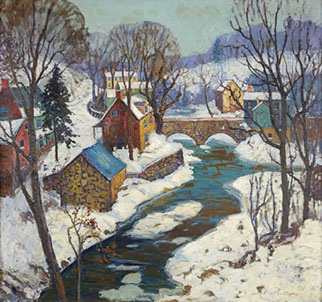
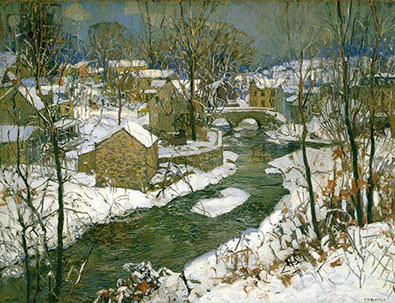
Compare Fern’s version of Carverville Creek to Edward Redfield’s more realistic depiction.
Fern Coppedge died in 1951, three years after her husband Robert, having achieved a degree of fame. At the time her snowscapes were selling for as much as $500-$1,000 (today $25,000 to $250,000), and serious art lovers and museums proudly displayed her prize paintings. In her will, Fern bequeathed 100 unsold paintings to a close friend, Aimee MacNeill, her architect’s wife, to distribute as she saw fit. We are still researching exactly what happened to those paintings, some of which were part of the Michener’s 1990 exhibition of 50 paintings. We have been in touch with the MacNeill family.
When she passed away in 1951, Fern Coppedge requested a simple Christian Science memorial ceremony. She was cremated, her ashes merged with the familiar flowing waters of the Delaware River which she lived next to and painted for 40 years in Lumberville and New Hope. Painting along the Delaware was a permanent assignment for all seasons, but especially in her favorite season: Winter.
Masterpieces
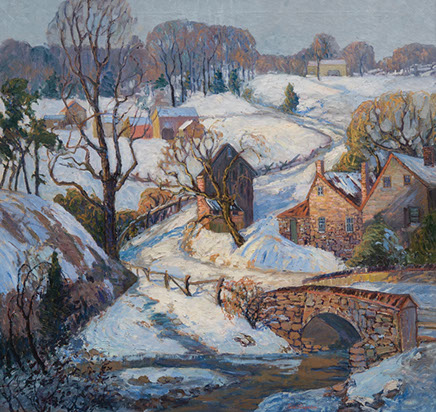
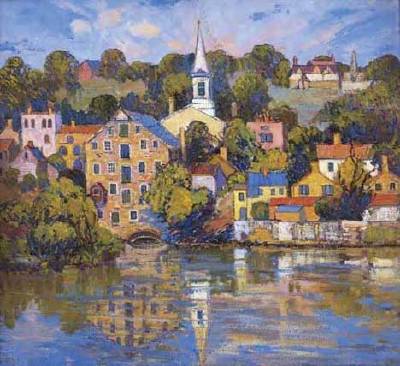
Fern Coppedge
Back Road to Pipersville, n.d.
Oil on Canvas
H. 38 x W. 40 inches
James A. Michener Art Museum. Gift of Robert J. Lillie.
1999.4
Reflections (Formerly Lambertville On The Delaware)
Gloucester


Gloucester Harbor
The Opalescent Sea
Return to Book
Visit the James A. Michener Museum in Doylestown, PA to see the largest public collection of Fern Coppedge paintings.
Fern Coppedge, the most fascinating member of The New Hope School, is considered to be the finest female painter of Winter Landscapes.
©2022. Fern Coppedge photos, letters amd stories? email: lesfoxnj@yahoo.com.